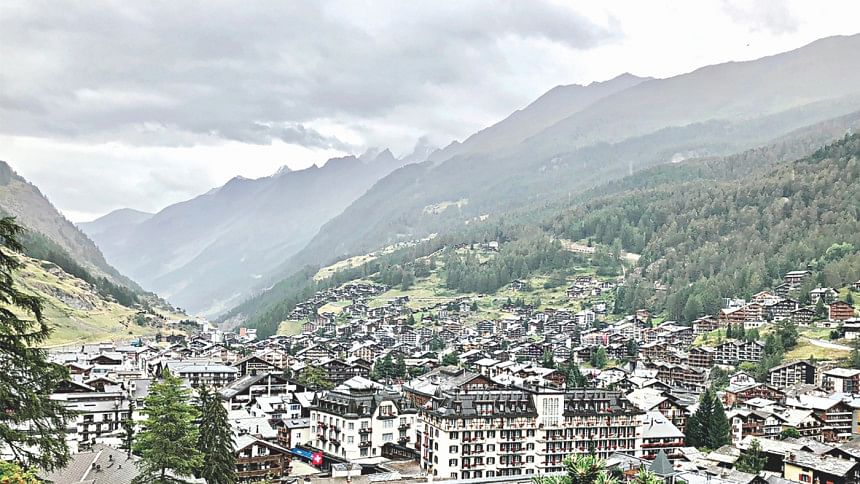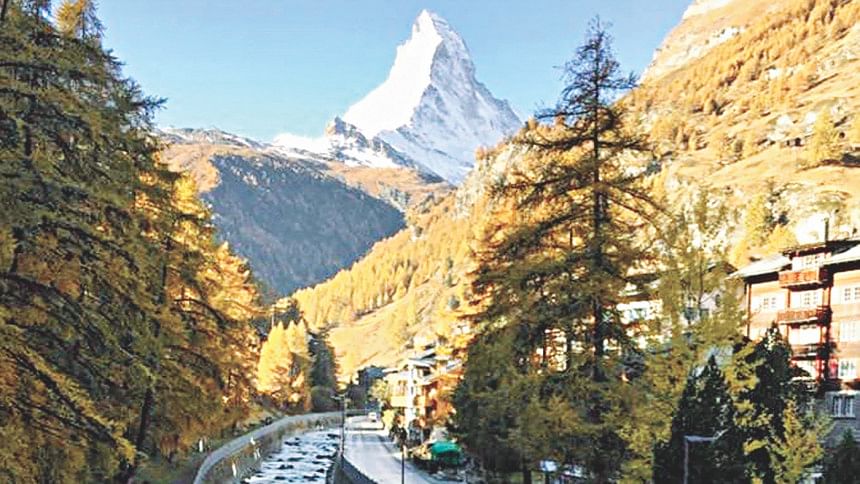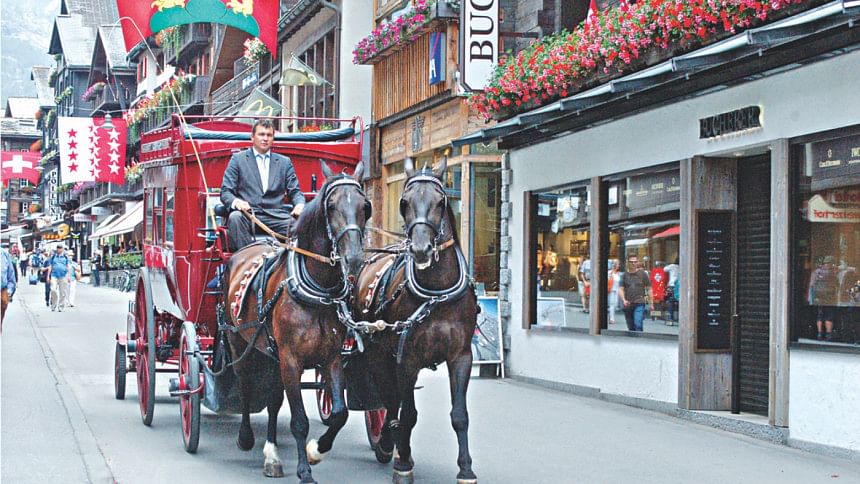Zermatt, the princess of the Alps

Zermatt, a paradise for skiers, is about three hours southeast of Geneva, nestled in the tall peaks of the Alps, hidden but from the most-zealous. It has a special cache because of how it attracts different clienteles, and what it possesses.
As we sped through the Jura mountains, we felt something much taller closing in on us from the French side of Lake Leman, as Geneva is close to the French border. The Alps gradually swooped down on us as we felt increasingly tinier. From deep down in the valleys, we descried the lovely towns artistically perched high up.
A lone archetypal chalet up on a slope surrounded by meadows and grazing cattle depicted the unperturbed serenity of the land, and the simple architectural elegance carved out of the foreboding landscape. Soon, the gentle valleys gave way to the winding roads and hair-pin bends up the sides of the tall mountains. Suddenly, a panorama of mountains — shrouded in white clouds and snow — blue lakes, and the daily Swiss lives in them, began to unfold to unlimited imagination. Appreciating every bend, we drove to Tasch, a gateway to Zermatt, marking the end of our drive.

The red-white Swiss train would take over from here to the scenic wonderland. Zermatt, in the Swiss canton of Valais, largely car-free, except for a few service vehicles– is an attribute piquing my curiosity.
On our arrival, we were greeted by a parade of road-hogging goats, sashaying with swagger. Skiers were everywhere, itching for adventure.
Zermatt was for the romantic wayfarers, skiers, and climbers. It welcomed us with a stunning landscape and a misty warmth. The refreshing spray from the mountains offered a whiff of the crisp thin air that reminded me of a shepherd describing how fresh mountain-air would cleanse his mind and body with every breath, and I could instantly feel it. As I inhaled every ounce of air, I soaked up every bit of freshness to become one with Zermatt.
Its buzzing main thoroughfare was lined with wooden chalets, floral beds, shops, restaurants, and drowned in horse clip-clops, yet Zermatt felt like a town lost in the clouds. Miniature Swiss flags hung overhead at intervals. Nearby, a horse-drawn carriage carried the dreams of a soon-to-be-wed couple. The eagerness to etch this place in one's memory seemed to follow different paths: adventure for some, romance for others. On the conifer-dotted slopes were neatly arranged chalets and homes. Hotel Omnia, a contemporary rendition of an American-style lodge, sat on a slope, blending modernism with local style. An artist could gently lay down her freshly-painted imaginations here for them to come alive in a three-dimensional reality. I could not distinguish this scene from those in the paintings, except that this one breathed, hummed, and smelled of life.
A little bit later, the ultimate icon, one of the tallest peaks of the Swiss Alps, the Matterhorn, meaning "peak of the meadows," emerged, shooting high into the sky.
My jaw dropped on sight. It looked like a slender triangle with its unique pyramidal snow-capped peak, eager to assert its authority over everything tall and rugged. The imposing presence said it all: she was the queen here.
Straddling Switzerland and Italy, it oversaw the marriage of two cultures and lifestyles. Its rich melted ice flows through the earthy veins of Zermatt in the form of roaring Gornera river, in an orchestral rhythm, blending seamlessly with the ringing calls of the Alpine Chough. Many brave mountaineers had attempted to summit the deadly Matterhorn. As in any story, the tale of Zermatt presents a grim reminder. It proudly caresses the souls of many who perished in their pursuit of the ultimate prize. It once lured them close by its charm just as it did me, but for a different reason. Leave they never could.

This cemetery was a sombre, but glowing testament to their pluck. One Donald Williams died a dreamer's death, but his was not the casualty of being forgotten. An integral part of her soul now, his resolve lives on among the indomitable climbers, encouraging them every day to never give up what he did not. His red ice axe stood out on his tombstone as a source of glowing inspiration.
Zermatt prides itself on being a gastronomical heaven. It boasts Michelin star restaurants and gourmet cuisine. I loved the classic Swiss dish rosti, consisting mainly of potato and cheese in the style of fritters. Considered a national dish by many, it is eaten primarily in the German-speaking cantons, one that Zermatt is in.
I finally left Zermatt with its pieces stitched to my heart, with a sense of awe for what I experienced, and a sense of emptiness at what I missed. Would I ever return to see what still lay unturned? The tall Matterhorn would always beckon me as a beacon to all that is unworldly. While this is intangible, I did want to part with something tangible, reminding me of Zermatt in my daily life. As mundane as it may be, the umbrella I bought — in the face of jokes — had a map of Zermatt drawn all over it, lest I forgot how to find it again, for it lay hidden deep.
I will find rain, as long as I live, and in it, I will rediscover my Zermatt. When it rains, I unwind my umbrella, my memory lane, and fondly listen. But is it just rain? Every raindrop is a heartbeat of Zermatt, the princess of the Alps. Red ice axe I do not have, but an umbrella I do.
Photo: Arif Shahjahan

 For all latest news, follow The Daily Star's Google News channel.
For all latest news, follow The Daily Star's Google News channel. 



Comments